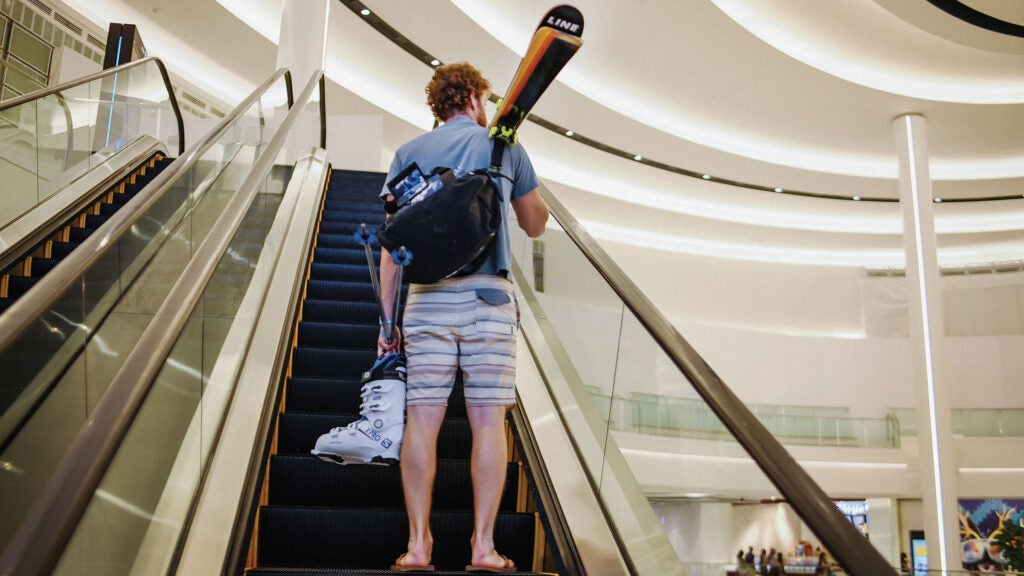No products in the cart.
Outdoor Adventure
Will Big Snow, America’s First Indoor Slope, Attract New Skiers to the Sport?
The car thermostat registered 81 degrees as I pulled into the multi-level cylindrical parking lot and gathered together my skis. I exited the car and joined the packs of rabid teenagers and flustered families streaming into the mall’s blindingly white entrance. Wearing a T-shirt and board shorts and lugging my skis and a duffel bag full of winter wear, I stared up into a familiarly luminous—if not downright garish—three-level scene of suburban capitalism, the American Dream mall. I spotted a Zara and a Foot Locker and a wholly mediocre food court. (Also, lots of empty storefronts.) Then there’s the entertainment: an aquarium, several theme parks, a Zen garden, two miniature golf courses—one Angry Birds-themed, the other alien-themed—and then, skiing.
You don’t arrive at the American Dream mall so much as you’re engulfed by it. One minute you’re plodding along on a highway in East Rutherford, New Jersey (about 17 miles from New York City), surrounded by big box stores and a number of Starbucks drive-thrus; the next you’ve been whisked into a labyrinth of concrete complexes, parking garages, and digital billboards flashing the words “Welcome to the Dream.” Should you venture to crane your neck you will see jutting into the atmosphere a massive covered ramp propped up by a network of steel girders.
This architectural curiosity has a name—Big Snow—and a rather lofty status: It is the country’s first indoor ski slope and arguably the mall’s biggest attraction. Though the slope opened in December 2019, the Covid-19 pandemic shuttered the facility in March; five months later, it re-opened. In a way then, my visit, in mid-July 2021, coincided with Big Snow’s approximate one-year anniversary. It’s still a baby, as far as resorts go—and, given the fact that just five new resorts have opened in the U.S. in the last 20 years, a very unique baby indeed.
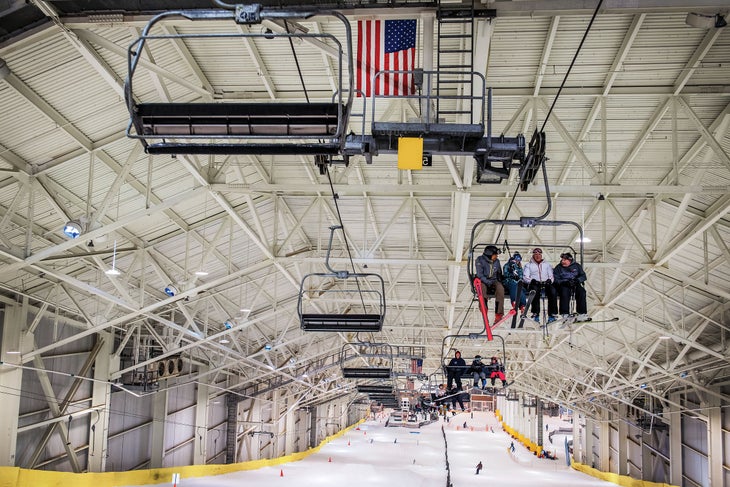
That the slope—and, really, the entire American Dream complex—is here at all is a minor miracle. Plans for the mall itself have been plagued with uncertainty since they were first announced in 1996: The original developer, Mills Corporation, ran into funding issues shortly after breaking ground on the mall in 2004. After the Mills Corporation went broke, the mall was purchased but the 2008 financial crisis doomed that enterprise. In 2011, a Canadian real estate firm bought the mall and renamed it American Dream. Ten years and $5 billion later, the quixotic dream has been realized.
Yet, in spite of everything, the mall is standing, and on a muggy summer day, I was standing in the thick of it, observing a convoy of children mounted atop motorized stuffed tigers zipping around the ground-floor atrium. I stepped between the toddlers and ascended an escalator to find myself face-to-face with the words “BIG SNOW” in bold LED lights, where I was greeted by Mark Dobrowolski, the resort’s bearded and affable manager. Strolling past the gear shop, where any mall-going schmuck could peruse the racks of outerwear and smattering of skis and snowboards, Dobrowolski told me that during the summer they see between 300 and 500 people per day. “Winter is our busiest time,” he said, “where we’re sold out day today.”
Related: Bode Miller invests in the future of indoor skiing
Over his shoulder, out past the floor-to-ceiling window behind him, and straight into the wintry beast: a 1,000-foot, 16-story climate-controlled ski run (where it’s always 28 degrees) housed inside of what looks like a fairly drab warehouse. The walls and ceilings are unadorned; the only embellishment comes at the base of the slope, where the entire wall facing the ski hill has been plastered over with an image of an alpine lodge. It looked to me like a very large, and very costly, walk-in refrigerator.
Save for the small beginner section, Big Snow is really just one run, split in half between a groomer and a terrain park, serviced by a quad chairlift that runs directly overhead. Giant wall-mounted air conditioning units hum endlessly and hundreds of lights (and quite a few snowmaking guns), affixed to support beams, point down on the dozens of skiers and snowboarders below. There’s also a snowcat that grooms the hill every few hours—not exactly a Sisyphean task, given that the slope registers just a 26-percent grade at its steepest point, which is comparable to a typical intermediate run. “It’s definitely lopsided toward beginners,” says Dobrowolski. “We’ve seen days where 90 percent of the people who come through are first-timers.”
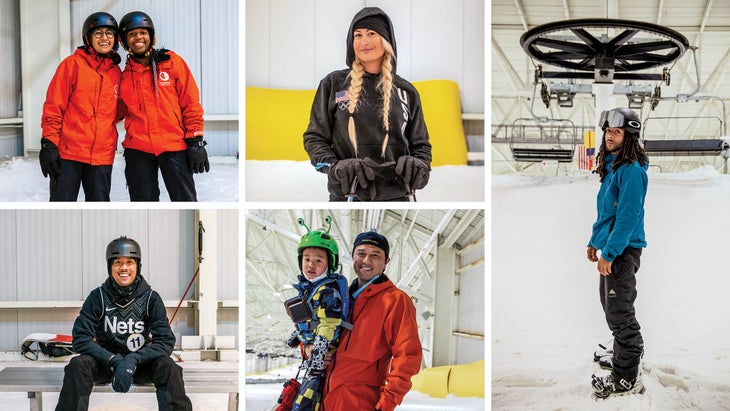
This became apparent once I clicked into my skis and took the three-minute lift ride to arrive at the summit. On the groomed side of the slope—called Switchback—a horde of neophytes, many of them sporting the facility’s red and orange rental jackets, slid slowly and awkwardly down the run, occasionally toppling over one another.
Ability aside, I immediately was struck by the diversity of the crowd. I saw Black skiers, brown skiers, and white skiers; Jewish, Hindu, and Muslim, some wearing religious indicators as they slipped across the snow. I met skiers from Florida and skiers from Japan, all of them lurching clumsily down a small patch of man-made snow. This might seem anecdotal, but it’s not: In a sport that skews overwhelmingly white—three-quarters of the 9.5 million Americans who ski are white, according to a survey by the SnowSports Industries America trade group—Big Snow has already been recognized as an industry leader, winning the inaugural Burton Diversity and Inclusion Award at last year’s National Ski Areas Association winter conference.
On that note: It’s time to reconsider what skiers think is cool
“It brings a lot of skiers and riders that normally wouldn’t be exposed to the sport,” says Allen Liou, a 41-year-old from Manhattan who comes up every weekend with his three-year-old son, Paxton. Big Snow provides a perfect teaching venue, Allen says, because “the conditions are pristine. It’s the perfect temperature, there are no icy patches.”
Skiing was always a central component of the American Dream, no matter who was financing it, but the development of the indoor slope was, like the mall itself, slow going. The turning point came when Triple Five brought in Joe Hession.
If you are an experienced downhill skier, you’re not going to Big Snow for the thrill of the piste … Maybe you’re just there for the novelty of skiing. In a mall. In New Jersey.
A native of Vernon, New Jersey, Hession grew up skiing Mountain Creek, where he got his first job as a parking lot attendant in 1994. Hession worked his way up the chain at Mountain Creek until he became the general manager in 2010.
But the Jersey boy couldn’t resist the call of the West—or, more accurately, couldn’t ignore his girlfriend’s (and now wife’s) desire to head West, and he eventually followed her out to Colorado. Not that he has any regrets about the matter. “My dream was to live in Colorado,” he said.
While living in Boulder, Hession began to wonder: Why did the ski industry have such a hard time luring in repeat customers? (According to an industry analysis, four out of five novice skiers and snowboarders don’t ever return.) And so in 2012, Hession’s consulting business, SNOW Operating, was born.
SNOW’s most significant offering is its Terrain-Based Learning program, which aims to fine-tune a mountain’s novice experience—namely by endowing instructors with a more rigid pedagogy and by constructing features like rollers and banked turns that make trails more beginner-friendly. “It’s basically shaping snow, and working with instructors on a methodology to take gravity out of your first time skiing and snowboarding,” says Hession.
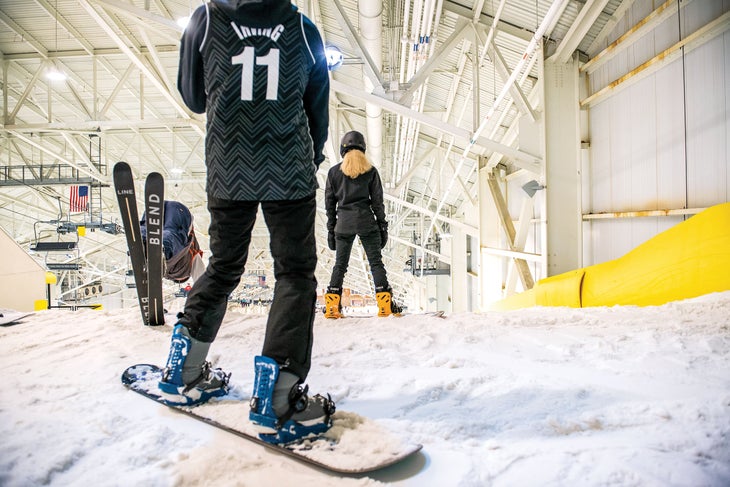
It sounds a little nebulous, but his philosophy has caught on—more than 40 resorts have licensed SNOW’s program, including Killington, Aspen Snowmass, and Whistler Blackcomb, where the program caught the eye of Don Ghermezian, the CEO of Triple Five, whose family is also behind the American Dream mall. A meeting between the two soon followed, when Hession discussed the ins and outs of operating a mountain.
“I said to Don, ‘What’s your plan?’ And he explained experiential relationships, the fact that malls in the ’80s and ’90s had anchor stores—the Macy’s and the movie theaters. In the future, instead of anchors being big department stores, it’s going to be amusements and attractions,” Hession says.“ By the time we were done talking, he literally ended the meeting with, ‘You have to run this thing, it has to be yours.’” Hession’s initial skepticism quickly melted away.
His handiwork was evident from the moment I walked into Big Snow: the ticketing system that does away with wickets in favor of a scannable wristband; the three stationary gondolas that house large televisions playing a safety video on loop; the set of gates that create a series of gently banking turns along the bunny slope. (This latter feature is where you can see the Terrain-Based Learning approach on full display.) It’s all very intentional, albeit a little sterile.
So far, the formula seems to be working, even in spite of a global pandemic. That’s not to say SNOW Operating didn’t take a few hits to its business, worst of all the passing of the original general manager, Jim Haas, who died in March as a result of complications caused by Covid-19.
The resort also took some serious financial blows during its five-month closure. The government’s Paycheck Protection Program facilitated a roughly $1 million loan to SNOW Operating in April 2020. Now, nine months after the mall’s re-opening, the resort is already profitable. Given that the number of active ski and snowboard participants in the U.S. has been in a steady decline over the last 10 years, maybe Big Snow—with its $70 gear-and-instruction day tickets and its close proximity to a major city—is the life raft the industry has needed.
“There are a lot of people, especially millennials, who don’t ski,” says Chris Diamond, former president of Steamboat Resort, “but now, as they gather around the water cooler in the office, are going to be listening to their friends talk about a recent trip and how much fun they had. The indoor facility is a great bridge.”
I heard that sentiment a few times over the day—essentially, that Big Snow was less intimidating than a normal slope—even if not everyone had the acumen to cite temperatures and snow quality. “I always wanted to try it, but this is easy and safe,” said Leila Kirton, a 19-year-old from nearby Chatham, New Jersey, who wore the branded red rental jacket that marked her as newer to the sport. “When we first got here, they told us roughly the basics: how to stop and how to turn. And then,” she waved toward the bunny slope, “we did the bank turns a few times.”
The other half of the slope, Northern Lights, was littered with well-maintained rails and boxes plus a nice little tabletop jump. The crowd here was unsurprisingly younger and more skilled; also unsurprisingly, many of them wore baggy sweatshirts. One of those skiers, 17-year-old Demarco Dinsmore, said he and a few buddies drove five-and-a-half hours from Uniontown, Pa., just to get their park fix. “But I think it’s super-duper worth it,” he said. His friend, Ryan Voyten, chimed in, “Everybody’s stoked to be here. You can’t really catch any bad vibes here.”
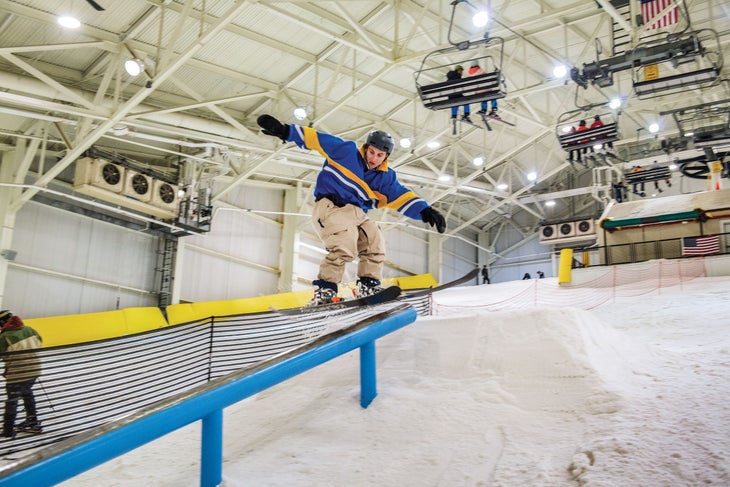
After watching the crew of young hucksters film each other sliding down a long, kinked rail, I joined the newbies on the groomer. I set off, arcing wide turns and weaving between cautious beginners. And then, in a few seconds, I had reached the bottom. I managed about 12 turns.
The snow was granulated and approachable (“kind of like a sand-snow,” as Hession put it), and the run was perfectly serviceable. It didn’t provide anything close to the elusive rapture—that ineffable sense of invincibility—that a good powder day might, but then, you can’t easily find powder in this hemisphere in July. But isn’t that beside the point? If you are an experienced downhill skier, you’re not going to Big Snow for the thrill of the piste; you’re there to watch gleeful novices learn how to pizza their planks and to see appreciative park rats spend hours perfecting their latest maneuver. You’re there for the community, the camaraderie, and to escape the heat. Maybe you’re just there for the novelty of skiing. In a mall. In New Jersey.
After a few more runs, I decided to call it a day. As I walked out of Big Snow and returned to the mall’s dazzling signs and motorized animals, I was stopped by a couple. “So, is it real skiing in there?” the woman asked in a dubious tone.
Without pause, I answered them: “Yeah, it is.”
Source link

